RENTAL ROUN
Page 56
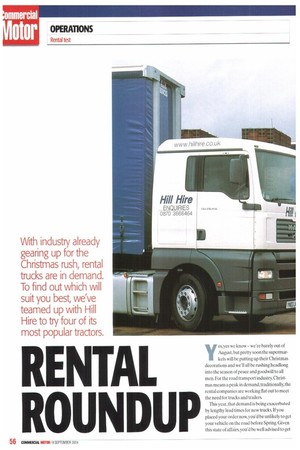
Page 57
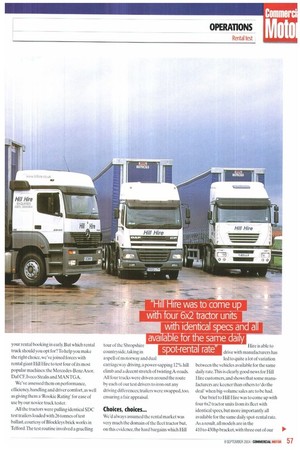
Page 58
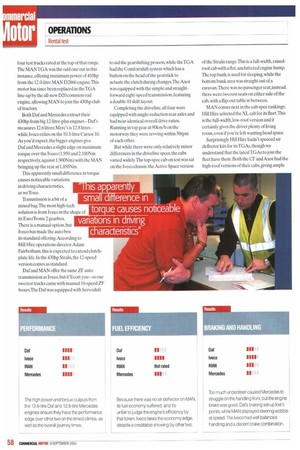
Page 59
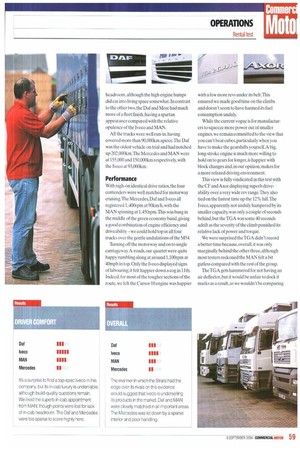
Page 60
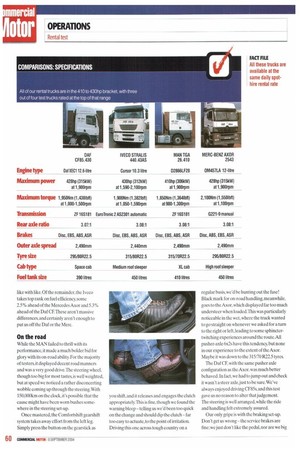
Page 61
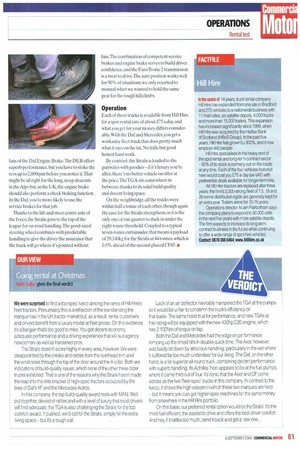
If you've noticed an error in this article please click here to report it so we can fix it.
yes, yes we know — we're barely out of August, but pretty soon the supermarkets will be putting up their Christmas decorations and we'll all be rushing headlong into the season of peace and goodwill to all men. For the road transport industry. Christmas means a peak in demand; traditionally, the rental companies are working flat out to meet the need for trucks and trailers.
This year, that demand is being exacerbated by lengthy lead times for new trucks If you placed your order now, you'd be unlikely to get your vehicle on the road before Spring. Given this state of affairs.you'd be well advised to get your rental booking in early. But which rental truck should you opt for? To help you make the right choice. we've joined forces with rental giant Hill Hire to test four of its most popular machines: the Mercedes-Benz Axor, Daf CF, Iveco Stralis and MANTGA.
We've assessed them on performance, efficiency, handling and driver comfort, as well as giving them a 'Rookie Rating' for ease of use by our novice truck tester.
All the tractors were pulling identical SDC test trailers loaded with 26 tonnes of test ballast, courtesy of Blockleys brick works in Telford.The test routine involved a gruelling tour of the Shropshire countryside, taking in a spell of motorway and dual carriageway driving, a power-sapping 12% hill climb and a decent stretch of twistingA-roads. All four trucks were driven around the route by each of our test drivers to iron out any driving differences; trailers were swapped, too, ensuring a fair appraisal.
Choices, choices...
We'd always assumed the rental market was very much the domain of the fleet tractor but, on this evidence, the hard bargains which Hill Hire is able to drive with manufacturers has led to quite a lot of variation between the vehicles available for the same daily rate.This is clearly good news for Hill Hire customers, and shows that some manufacturers are keener than others to•do the deal' when big-volume sales are to he had.
Our brief to Hill Hire was to come up with four 6x2 tractor units from its fleet with identical specs, but more importantly all available for the same daily spot-rental rate. As a result, all models are in the 410 to 430hp bracket, with three out of our 111' four test trucks rated at the top of that range. The MAN TGA was the odd one out in this instance, offering maximum power of 410hp from the 12.0-litre MAN D2866 engine-This motor has since been replaced in the TGA line-up by the all-new D20 common-rail engine, allowing MAN to join the 430hp club of tractors.
Both Daf and Mercedes extract their 430hp from big 12-litre-plus engines — Dafs measures 12.6 litres; Merc's is 12.8 litres — while Iveco relies on the 10.3-litre Cursor 10. As you'd expect, the bigger engines give Daf and Mercedes a slight edge on maximum torque over the Iveco (1,950 and 2.100Nm respectively, against 1,900Nm) with the MAN bringing up the rear at 1,850Nm.
Transmission is a bit of a mixed bag.The most high-tech solution is from Iveco in the shape of its EuroTronic 2 gearbox. There is a manual option,but Iveco has made the auto box its standard offering. According to Hill Hire operations director Adam Fairbotham, this is expected to extend clutchplate life. In the 430hp Stralis, the 12-speed version comes as standard.
Daf and MAN offer the same ZF auto transmission as Iveco, but it'll cost you —so our two test trucks came with manual 16-speed ZF boxes.The Daf was equipped with Servoshift to aid the gearshifting process, while the TGA had the Cornfortshift system which has a button on the head of the gearstick to actuate the clutch during changes.The Axor was equipped with the simple and straightforward eight-speed transmission,featuring a double-H shift layout.
Completing the driveline, all four were equipped with single-reduction rear axles and had near-identical overall drive ratios. Running in top gear at 90km/h on the motorway they were revving within 50tTim of each other.
But while there were only relatively minor differences in the driveline specs, the cabs varied widely.The top-spec cab on test was sat on the Iveco chassis: the Active Space version of the Stralis range.This is a full-width, raisedroof cab with a flat,uncluttered engine hump. The top bunk is used for sleeping, while the bottom bunk area was straight out of a caravan.There was no passenger seat; instead, there were two rest seats on either side of the cab, with a flip-out table in between.
MAN comes next in the cab-spec rankings; Hill Hire selected the XL cab for its fleet.This is the full-width, low-roof version and it certainly gives the driver plenty of living room, even if you're left wanting head space.
Surprisingly Hill Hire hadn't specced air deflector kits for its TGAs, though we understand that the latest TGAs to join the fleet have them. Both the CF and Axor had the high-roof versions of their cabs, giving ample headroom, although the high engine humps did eat into living space somewhat. In contrast to the other two,the Daf and Mere had much more of a fleet finish, having a spartan appearance compared with the relative opulence of the Iveco and MAN.
All the trucks were well run-in, having covered more than 90,000km apiece.The Daf was the oldest vehicle on trial and had notched up 202.000krn.The Mercedes and MAN were at 155,000 and 150,000km respectively. with the Iveco at 93,000km.
Performance
With nigh-on identical drive ratios, the four contenders were well matched for motorway cruising.The Mercedes, Daf and Iveco all registered 1, 40Orprn at 90km/h, with the MAN spinning at 1.45Orpm.This was bang in the middle of the green economy band,giving a good combination of engine efficiency and driveability — we could hold top in all four trucks over the gentle undulations of the M54.
Turning off the motorway and onto single carriageway A-roads, our quartet were quite happy rumbling along at around 1,100rpm at 40mph in top. Only the Iveco displayed signs of labouring; it felt happier down a cog in 11th. Indeed, for most of the tougher sections of the route, we felt the Cursor 10 engine was happier with a few more revs under its belt.This ensured we made good time on the climbs and doesn't seem to have harmed its fuel consumption unduly.
While the current vogue is for manufacturers to squeeze more power out of smaller engines, we remain committed to the view that you can't beat cubes, particularly when you have to make the gearshifts yourselLA big, long-stroke engine is much more willing to hold on to gears for longer, is happier with block changes and, in our opinion, makes for a more relaxed driving environment.
This view is fully vindicated in this test with the CF and Axor displaying superb driveability over a very wide rev range.They also tied on the fastest time up the 12% hill.The Iveco, apparently not unduly hampered by its smaller capacity, was only a couple of seconds behind, but the TGA was some 40 seconds adrift as the severity of the climb punished its relative lack of power and torque.
We were surprised the TGA didn't record a better time because, overall, it was only marginally behind the other three, although most testers reckoned the MAN felt a bit gutless compared with the rest of the group.
The TGA gets hammered for not having an air deflector, but it would be unfair to dock it marks as a result, as we wouldn't be comparing like with like. Of the remainder, the Iveco takes top rank on fuel efficiency, some 2.5% ahead of the Mercedes Axor and 5.3% ahead of the Daf CEThese aren't massive differences, and certainly aren't enough to put us off the Daf or the Mere.
On the road
While the MAN failed to thrill with its performance, it made a much bolder bid for glory with its on-road ability. For the majority of testers, it displayed decent road manners and was a very good drive,The steering wheel, though too big for most tastes, is well weighted, but at speed we noticed a rather disconcerting wobble corning up through the steering. With 150,000km on the clock, it's possible that the cause might have been worn bushes somewhere in the steering set-up.
Once mastered, the Comfortshift gearshift system takes away effort from the left leg. Simply press the button on the gearstick as you shift, and it releases and engages the clutch appropriately. This is fine, though we found the warning bleep — telling us we'd been too quick on the change and should dip the clutch — far too easy to actuate, to the point of irritation. Driving this one across tough country on a regular basis, we'd be hunting out the fuse! Black mark for on-road handling, meanwhile. goes to the Axor, which displayed far too much understeer when loaded.This was particularly noticeable in the wet, where the truck wanted to go straight on whenever we asked for a turn to the right or left, leading to some sphinctertwitching experiences around the route. All pusher-axle 6x2s have this tendency, but none in our experience to the extent of the Axor. Maybe it was down to the 315/70 R22.5 tyres, The Daf CF, with the same pusher axle configuration as the Axor,was much better behaved. In fact, we had to jump out and check it wasn't a steer wde,just to be sure. We've always enjoyed driving CF85s, and this test gave us no reason to alter that judgement. The steering is well arranged, while the ride and handling felt extremely assured.
Our only gripe is with the braking set-up. Don't get us wrong — the service brakes are fine; we just don't like the pedal,nor are we big fans of the Dal Engine Brake.The DEB offers superb performance. but you have to stoke the revs up to 2,000rpm before you notice it.That might be all right for the long, steep descents in the Alps but, in the UK, the engine brake should also perform a check braking function. In the Daf. you're more likely to use the service brakes for that job.
Thanks to the lift-and-steer centre axle of the Iveco, the Stralis goes to the top of the league for on-road handling.The good-sized steering wheel combines with predictable handling to give the driver the assurance that the truck will go where it's pointed without fuss.The combination of competent service brakes and engine brake serves to build driver confidence, and the EuroTronic 2 transmission is a treat to drive. The auto position works well for 90% of situations; we only resorted to manual when we wanted to hold the same gear for the tough hill climbs.
Operation
Each of these trucks is available from Hill Hire for a spot rental rate of about 05 a day, and what you get for your money differs considerably. With the Dal and Mercedes, you get a workaday fleet truck that does pretty much what it says on the tin. No frills, but good honest hard work.
By contrast. the Stralis is loaded to the gunwales with goodies if it's luxury you're after, there's no better vehicle on offer at the price.The TGA sits somewhere in between, thanks to its solid build quality and decent living space.
On the weighbridge. all the trucks were within half a tonne of each other, though again the case for the Stralis strengthens, as it is the only one of our quartet to duck in under the eight-tonne threshold. Coupled to a typical seven-tonne curtainsider. that means a payload of 29,140kg for the Stralis at 44 tonnes, which is 0.5% ahead of the second-placed CF85.




























































































































































































